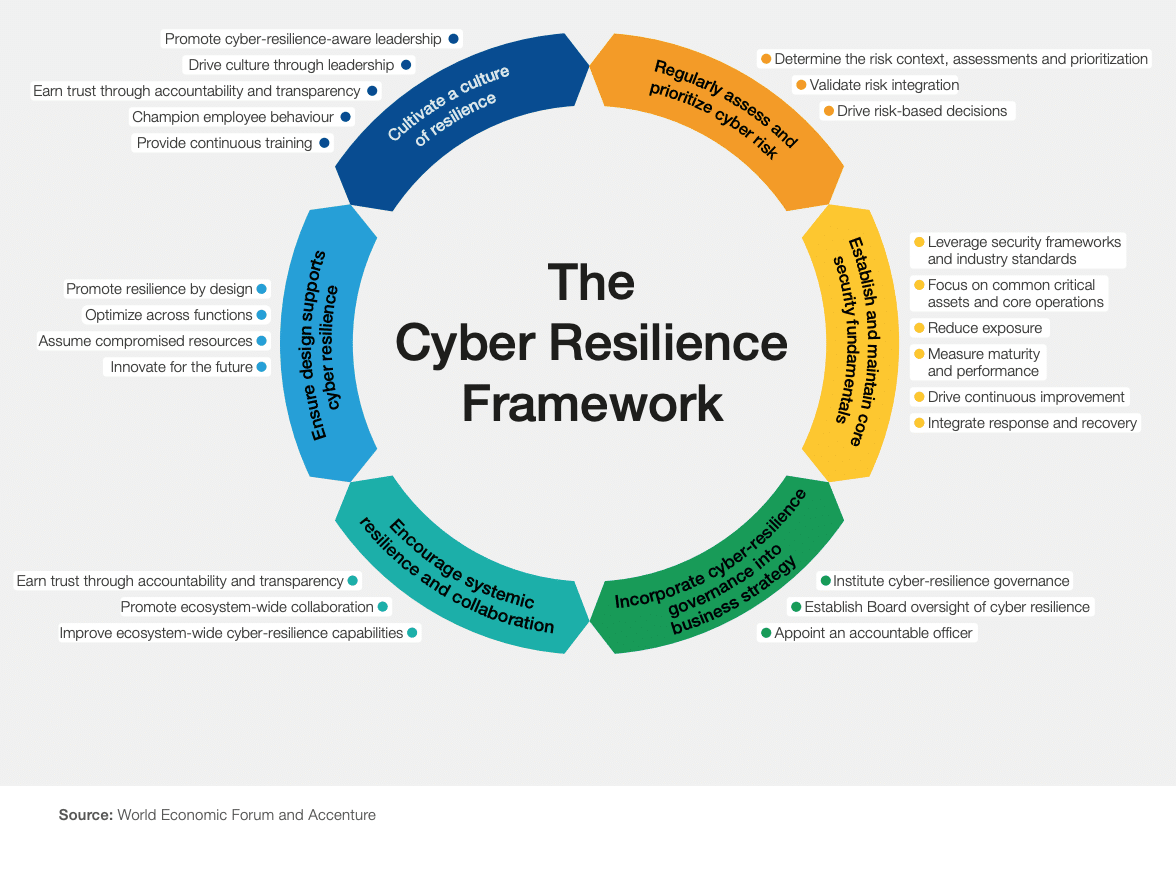Cyber Resilience: Strengthening Your Business Against Threats
In today’s digital age, cyber resilience has become a cornerstone of effective cybersecurity strategies, enabling organizations to thrive amidst the constant threat of cyberattacks. As incidents like the SolarWinds hack and JBS cyberattack demonstrate, the need for robust cyber risk management practices is paramount for both private and public sectors. Organizations must not only focus on preventing cyber threats but also prepare to maintain business resilience during and after an attack. By implementing a comprehensive approach to protecting businesses from cyber threats, organizations can minimize losses and recover swiftly. Resources such as those provided by CISA, alongside strategic practices, empower companies to bolster their defenses and ensure continuity in the face of adversity.
When we talk about safeguarding digital assets, concepts like cyber defense and organizational robustness become increasingly significant. Effective protection against online vulnerabilities can sometimes be overlooked, yet emphasizes the importance of harmony between security measures and business continuity. As businesses navigate through the complexities of digital threats, the implementation of a coherent cybersecurity plan enhances resilience against potential disasters. Moreover, attention to aspects like risk assessment and vulnerability management ensures that companies remain steadfast in their operations, even under duress. Turning to authoritative resources and guidelines can significantly bolster an organization’s aptitude for dealing with unforeseen cybersecurity challenges.
Understanding Cyber Resilience: A Key Component of Cybersecurity Strategy
Cyber resilience refers to an organization’s ability to prepare for, respond to, and recover from cyber incidents effectively. It is not merely about preventing attacks, as the evolving landscape of cyber threats makes it clear that no system is entirely foolproof. Instead, a robust cyber resilience strategy focuses on creating a framework that enables businesses to quickly bounce back after a cyber event. Companies must recognize that cyber attacks can and will happen, and by prioritizing resilience, they can minimize disruption to operations and ensure continuity. Key components of this strategy include regular training for staff on cybersecurity best practices, testing of incident response plans, and continuous improvement of cyber hygiene across all levels of the organization.
Implementing a cyber resilience strategy also involves understanding and managing cyber risks effectively. By utilizing tools such as risk and vulnerability assessments and engaging with resources like CISA’s cyber tools, businesses can identify potential weaknesses in their cybersecurity posture. For instance, companies might conduct a detailed analysis of their susceptibility to ransomware or phishing attacks and develop tailored response strategies. Thereby, businesses can not only prepare for immediate threats but also strengthen their long-term cybersecurity outlook.
Moreover, the role of leadership within an organization is critical for fostering a culture of cyber resilience. Executive buy-in and commitment are essential for the successful adoption of cybersecurity strategies throughout the company. Leaders should proactively engage with cybersecurity training initiatives, ensuring that all employees—from entry-level to executives—understand their roles in safeguarding organizations against cyber threats. This structural commitment creates an environment where personnel are empowered to act decisively in the face of cyber incidents. With a well-defined cyber resilience program, organizations can effectively manage potential threats and safeguard their assets, thus enhancing their overall business resilience.
Effective Cyber Risk Management: Strategies for Protecting Businesses
Effective cyber risk management is about proactively identifying and mitigating vulnerabilities that could lead to data breaches or cyber attacks. Organizations can adopt various strategies to protect themselves from the dynamic landscape of cyber threats. One crucial step is to develop a comprehensive cybersecurity strategy that aligns with industry best practices and legal requirements. This may include the implementation of advanced security measures such as firewalls, intrusion detection systems, and data encryption. Additionally, continuous monitoring and updating of security protocols are essential to thwart evolving threats. Organizations should also leverage guidelines provided by entities such as CISA, which outlines effective cybersecurity practices and resources tailored for specific industries.
Another critical aspect of cyber risk management involves regular training and awareness programs for employees. An organization’s first line of defense against cyber threats is its workforce. By providing employees with knowledge about identifying phishing attempts, securing passwords, and understanding the importance of data protection, companies can significantly reduce their risk exposure. Furthermore, businesses should conduct simulated cyber attack exercises, allowing staff to practice their responses in controlled environments, thus fostering preparedness around real-world scenarios. Such practical training promotes a culture of vigilance and accountability, which is vital for safeguarding sensitive business information.
Ultimately, businesses should recognize that cyber threats are not static; they evolve rapidly, necessitating a flexible and adaptive risk management approach. Regular reviews and updates of risk management strategies are vital to ensure they remain relevant and effective. Additionally, engaging with trusted cyber resources, like CISA’s guidance on cyber risk management, can equip organizations with necessary insights and tools to enhance their defenses against cyber threats. Continuous improvement of cybersecurity practices, informed by both internal experiences and external benchmarks, will pave the way for long-term security and resilience.
Building Business Resilience Through Cybersecurity
Business resilience encompasses more than just systems and technology. It involves creating an organizational culture that prioritizes cybersecurity as an integral component of operational strategy. Companies must recognize that their ability to withstand and recover from a cyber attack is closely linked to their overall resilience as a business. By integrating cyber resilience into business continuity plans, organizations can ensure they are not just focusing on preventing attacks but also preparing for effective recovery. This means establishing clear communication channels, defining roles during incidents, and maintaining up-to-date incident response plans that can be activated promptly when needed.
Moreover, organizations should actively assess their current cybersecurity posture and identify areas of vulnerability that could jeopardize business operations. Regularly engaging in risk assessments and updating strategies as needed can prepare a business for potential cyber threats. This approach strengthens not just cybersecurity defenses, but also contributes to overall business resilience, allowing companies to navigate disruptive events with confidence. By balancing both prevention and recovery strategies, businesses can create a holistic approach to managing cyber risks, ultimately supporting sustainability and growth.
Furthermore, utilizing forums like CISA and other cybersecurity resources can significantly enhance an organization’s resilience efforts. Businesses can access valuable content, including guides on establishing resilient cybersecurity practices and the latest threat intelligence. Collaborating with industry partners and cybersecurity experts to share knowledge and best practices fosters a community-wide commitment to tackling cyber threats effectively. This ecosystem of shared learning enhances every participant’s ability to respond to threats, ultimately leading to a more resilient business landscape where companies can thrive even amid adversity.
Leveraging CISA Cyber Resources for Improved Cybersecurity
CISA offers a wealth of resources designed to aid businesses in enhancing their cybersecurity measures. From tools that assess vulnerabilities to extensive guides on best practices, businesses can tap into CISA’s expertise and information. Utilizing resources like CISA’s Cyber Essentials Starter Kit, organizations can implement basic cybersecurity measures that are crucial for protecting sensitive data, thereby laying a solid foundation for a more comprehensive cybersecurity strategy. Furthermore, CISA provides guidance specifically tailored for small businesses, ensuring that even organizations with limited resources can adopt effective cybersecurity measures without overwhelming their budgets or teams.
In addition to foundational resources, CISA also provides specialized toolkits that address current trends and tactics used by cybercriminals. For example, the Ransomware Guide offers practical advice for preventing and responding to ransomware incidents, while materials concerning phishing attacks equip organizations to identify and resist these common threats. By regularly consulting these valuable resources and integrating them into their cybersecurity strategies, businesses not only improve their protective measures but also enhance their overall readiness to tackle cyber risks. Awareness and proactive engagement with CISA resources ensure that organizations stay one step ahead of potential cyber threats.
Another notable feature of CISA’s offerings is its comprehensive archive of training materials and videos available on platforms like YouTube. These educational resources cover a wide range of cybersecurity topics, enabling staff across various roles to enhance their understanding of threat landscapes. By encouraging participation in such training, businesses can make significant strides in cultivating a culture of cybersecurity awareness within the organization. Such training initiatives empower employees, elevate organizational readiness, and create a resilient workforce that can mitigate the impact of cyber threats effectively. Engaging proactively with CISA’s resources strengthens an organization’s security posture and promotes ongoing resilience.
Frequently Asked Questions
What is cyber resilience, and why is it important for my cybersecurity strategy?
Cyber resilience is the capability of an organization to prepare for, respond to, and recover from cyber attacks. It is essential as it ensures that, irrespective of the threat landscape, your cybersecurity strategy is robust enough to manage incidents effectively, minimizing downtime and financial loss.
How can I improve my business resilience against cyber threats?
Improving business resilience involves implementing a comprehensive cyber risk management plan. This includes regular risk assessments, employee training, updating cybersecurity policies, and utilizing resources from CISA for best practices and tools to enhance your organization’s defenses against cyber threats.
What role do cybersecurity incidents like the SolarWinds hack play in shaping cyber resilience?
Incidents such as the SolarWinds hack highlight the vulnerabilities in cybersecurity infrastructures. By analyzing these events, businesses can adapt their cybersecurity strategies to bolster cyber resilience, ensuring they are better prepared to mitigate risks and recover from potential breaches.
What tools are available for managing cyber risks effectively?
There are numerous tools available for managing cyber risks, including CISA’s Risk and Vulnerability Assessment Tools. These tools can help you assess your current cybersecurity posture, identify vulnerabilities, and implement strategies to enhance resilience.
How does a ransomware guide fit into a cyber resilience strategy?
A ransomware guide is crucial for a cyber resilience strategy as it provides actionable steps for prevention and response. This guide helps organizations prepare adequately for the threat of ransomware, ensuring that they can respond swiftly and effectively to minimize damage.
What resources does CISA offer for businesses looking to strengthen their cybersecurity strategy?
CISA offers a wide range of resources, including a comprehensive cybersecurity archive filled with tools, tips, and best practices. These resources can significantly aid in enhancing your business’s resilience against cyber threats, making them invaluable for developing effective cybersecurity strategies.
How can recognizing common cyber threats contribute to my organization’s resilience?
Recognizing common cyber threats, such as phishing and ransomware attacks, empowers organizations to implement proactive prevention measures. This knowledge is a foundational element of a robust cyber resilience strategy, enabling businesses to act quickly and minimize impact when incidents occur.
What should I focus on to create an effective cyber risk management plan?
An effective cyber risk management plan should prioritize risk assessment, employee training, incident response planning, and continuous improvement through regular reviews of your cybersecurity policies. Incorporating lessons learned from past incidents is also critical to strengthening your organization’s overall resilience.
Why is it unrealistic to eliminate all cyber risks, and how does cyber resilience address this?
Complete elimination of cyber risks is unrealistic due to the ever-evolving nature of cyber threats. Cyber resilience addresses this by preparing organizations to withstand, respond to, and recover from attacks rather than just focusing on prevention.
What is the significance of having a cyber insurance like Central’s Cyber Suite Coverage?
Central’s Cyber Suite Coverage is vital for businesses handling sensitive data. It provides financial protection against various cyber incidents, thereby supporting a cyber resilience strategy by helping organizations recover swiftly from attacks, thus minimizing potential losses.
| Key Point | Details |
|---|---|
| Evolving Cyber Risks | Cyber threats are increasing in scope and cost to both public and private sectors. |
| Significant Incidents | Notable attacks include the SolarWinds hack and JBS cyberattack affecting major industries. |
| Importance of Resilience | Cyber resilience focuses on preparation and management of the aftermath of attacks rather than prevention alone. |
| Cybersecurity Resources | CISA offers a variety of tools and guides to help businesses manage cyber risks effectively. |
| Elimination of Cyber Risk | Complete elimination is unrealistic; resilience strategies help businesses recover quickly. |
| Central’s Cyber Suite Coverage | Provides coverage for data compromise, cyber extortion, and identity recovery. |
Summary
Cyber resilience is essential for businesses facing the growing threat of cyber attacks. As cyber risks evolve, companies must prepare for the aftermath of incidents rather than aim for absolute prevention. This involves implementing effective strategies to recover swiftly from any potential breach, ensuring minimal impact on operations. Resources such as CISA’s guides can significantly enhance a company’s ability to manage cyber risks, making resilience a core component of any robust cybersecurity plan.







